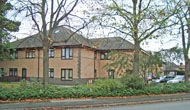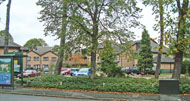Epsom
Isolation Hospital
Hook Road, Epsom, Surrey KT18 8UD
Medical
dates:
Medical
character:
Infectious diseases
In 1893 Epsom Urban District Council decided not to join Epsom Rural Council and Sutton and Leatherhead District Councils in establishing a joint isolation hospital, but to build one of its own. A site was chosen beside the gravel pits and sewage farm in Kingston Lane (later renamed Hook Road) and building commenced.
The Epsom Isolation Hospital opened in 1893. It had an administration block and a ward block containing two wards (one large and one small) for scarlet fever patients (with a nurse's room in between), and another large ward for all other patients for example, those with typhoid fever, 'continued fever' and diphtheria.
The Hospital was not always occupied; such hospitals had primarily been established to isolate and treat infectious cases and thus prevent epidemics. When epidemics became rampant, however, no isolation had enough beds for the numbers affected.
The nurse, who acted as caretaker when the Hospital was empty, received a monthly payment of £11 12s (£11.60). When there were in-patients, she was paid an extra 3 shillings (15p) a week. Patients were also nursed in their own homes.
In October 1897 the Urban District Council received a request from one of the GPs for an extra ward to be added, but no decision was made. In the following month an epidemic of scarlet fever occurred and the Hospital was filled, as was the Joint Isolation Hospital at Cuddington.
In March 1898, on examining the Hospital's account books for the past year, the Council noted that a gallon of ale had been charged one day, a gallon of stout the next and a bottle of brandy later. During this period the Hospital had contained 4 nurses and 25 patients. The yearly expenditure had come to £115, and it was decided that the accounts should be examined monthly rather than yearly.
In 1902 an additional ward was built. The Hospital then had 22 beds.
In 1925 Surrey County Council suggested that the Urban District Council should close the Hospital and make arrangements for infectious diseases patients to be admitted to Cuddington Hospital. The Council debated the issue but finally decided not to close the Hospital as, while the standard bed complement recommended by the Local Government Board was one bed for each 1,000 inhabitants, in Epsom the proportion (excluding the local mental hospitals) was about 1.5 beds per 1,000 people. Cuddington Hospital had 76 beds for a population of 76,215 - just under one bed per 1,000.
The Hospital remained open until the outbreak of WW2.
Present status (November 2009)
The buildings remained vacant for two decades, and then were demolished. In the mid 1970s an apartment block was built on the site. This, too, has now been demolished.
In 1992 Tomlin Court, a new development of 42 apartments was built on the site by Rosebery Housing Association, in a new close - Tomlin Close.


Tomlin Court (above and below)


Abdy C 2001 Epsom Past. Chichester, Phillimore.
http://edithsstreets.blogspot.com
http://epsomandewellhistoryexplorer.org.uk
Personal communication: Grateful thanks are given to the volunteers at the Epsom and Ewell Local and Family History Centre, who provided much information on this Hospital.
Return to home page